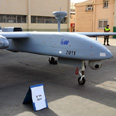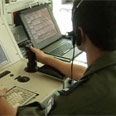
The Shoval
Photo: Michael Kremer

UAV control center
Photo: Roee Gazit
The Israel Air Force's busiest operational tools have to be its Unmanned Aerial Vehicles. Several of them roam the skies at any given time, controlled by a command center at the Palmachim base in central Israel.
The drones handle about a third of the IAF's missions. "They fly wherever needed, even if it's a long-range flight," Major Gil, deputy commander of the IAF's UAV squadron, told Ynet.
Nicknamed the Shoval ("Trail"), the UAV can stay airborne for nearly 40 hours and reach faraway destinations at that. "It can take on any mission the Air Force wants it to," said Gil, following foreign publications suggesting drones took part in an alleged Israeli strike on an arms convoy in Sudan, in early 2009.
As the Air Force gears for the decades ahead, the UAVs stand to be dealt a bigger piece of the operational pie: "We try to use UAVs whenever and wherever there is no relative advantage to the use of a manned plane," said Gil. "I estimate that by 2030, 50% of aircrafts used will be unmanned."

Complexities of a joystick
The operational aspect of controlling a UAV is split between two people – the one responsible for making sure it takes off and lands safely, and the one tasked with controlling its aerial maneuvers.
Moving the control panel's joysticks may look simple, but it takes precision skills and extensive experience. The little machine has become an IDF staple, says Gil, "And every commander would tell you that he would love to have UAVs to provide him with real-time images and information.
"Its flexibilities allow us to cater to a division commander in the Gaza Strip one minute, move to a spot over the West Bank the next and fly to the northern border on the third."
Shoval UAVs are routinely used to scan the various military sectors and build the IDF's "target bank." At wartime, however, they become a major operational tool, locating rocket launching pads and fire hubs.
The Palmachim squadron is currently expanding, "as the IAF is undergoing a process of enlarging its unmanned alignment. We have quite a few missions that have gone from manned to unmanned operations," said Gil.
The UAV control center gives an accurate image of the situation on the ground. In Gaza, says Gil, "you can see the urban density and the way in which the terror groups operate, so we are no longer surprised when children arrive in live-fire areas to collect rocket tripods.
"The IDF has more operational freedom in the West Bank – we can get the intelligence and carry out our mission within hours. The northern border is something we keep track of off the time, so we won't be caught off guard," he added.
The enemy, he says, is always trying to find new ways to eliminate the IDF's "eye in the sky": "They are well aware of the fact that there are UAVs hovering over them, watching, but they can't hide forever. We have patience. The aircraft are patient and they can stay up there for as long as it takes."















